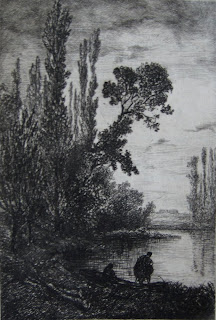Alphonse Charles Masson (1814-1898)
Portrait of Alfred Cadart
Etching, 1874
In 1862 Cadart founded the Société des Aquafortistes, which lasted until 1867. In 1868 he founded the journal L'Illustration Nouvelle, and in 1870 he restarted his publishing house at 58, rue Neuve-des-Mathurins, publishing etchings at a furious rate until his premature death in 1875, after which his widow took over the business. All of Cadart's enterprises were undertaken in association with the master printer Auguste Delâtre.
Advert for Cadart's "petite presse"
Cadart didn't just organize everything and publish everyone. He sold all you needed to start etching, from a proofing press at 150 francs to "éclats du Levant" to sharpen your etching needle at 50 centimes. More than that, he offered free etching lessons, and set aside a studio for artists to bite their plates and make trial proofs. In 1866 he published Maxime Lalanne's Traité de la Gravure à l'Eau-forte, and in 1873 followed this with A.-P. Martial's Nouveau Traité de la Gravure a l'Eau-Forte pour les Peintres et les Dessinateurs, two detailed and lucid how-to guides.
François Nicolas Augustin Feyen-Perrin (1826-1888)
Cancalaise
Etching, 1874
I've just acquired a fascinating catalogue of Cadart's published etchings from 1868-1874: Catalogue Complet d'Eaux-fortes Originales et Inédites Composées et Gravées par les Artistes eux-mêmes. It begins by listing 247 etchings published in L'Illustration Nouvelle up to mid-way through 1874. Then 2 collections of L'Eau-Forte depuis douze ans, consisting of 100 plates each. Then an enormous list alphabetically by artist of all the Principales Publications de la Maison Cadart. Then all his special publications dealing with the Siege of Paris and the Commune. And finally the 30 plates from l'Album Cadart for 1874.
Adolphe Lalauze (1838-1906)
Female performer
Etching, 1874
Even this comprehensive list doesn't contain all Cadart's work - there's nothing beyond mid-1874, and nothing to do with the Société des Aquafortistes and the failed firm of Cadart et Luquet. And - weirdly - it contains no list of the 12 new etchings contained within the catalogue itself, just a list of the 11 artists responsible for them.
Alfred Taiée (1820-1880)
Aux Champs Elysées
Etching, 1874
The copy I have acquired of Cadart's catalogue contains just 7 of the promised "douze planches types divers", with the remaining 5 in photocopy. The copies (not reproduced in this post) are by Jules Jacques Veyrassat, Charles Beauverie, Maxime Lalanne, Adolphe Potemont Martial, and Adolphe Lalauze (who contributed two etchings). The remaining 7 are posted here. They are all printed on laid paper. The etching by Alfred Taiée, and the missing ones by Beauverie and Martial, credit Imp. A. Cadart as the printer, though I suspect this really means Delâtre, for Cadart.
Pierre Teysonnières (1838-1919)
Border of a river
Etching, 1874
I already have etchings by 5 of the artists, but am particularly thrilled to acquire a really stunning example of the work of the important precursor of the Impressionists, Adolphe Appian.
Adolphe Appian (1818-1898)
Fishing boats in a harbour
Etching, 1874
Alphonse Édouard Aufray de Roc'Bhian (1833-1886)
Fishermen on a riverbank
Etching, 1874
My other "new" artist is Aufray de Roc'Bhian; the work is unsigned, and it was only by the process of elimination that I managed to work out who it was by.








"Fishing Boats In A Harbor" reminds me of Puul Signac's etchings, but it might be earlier? I wonder if he influenced Signac or a common response to the arrival of ukiyo-e prints in France. It stands out in this group as s different way of filling the spaces in the image.
ReplyDeleteAppian is earlier than Signac; I haven't so far been able to identify the harbour, but it may well be one Signac also painted. Adolphe Appian is one of the oddments of French art - a friend and pupil of Corot and Daubigny, and frequent visitor to Barbizon, yet not part of the Barbizon School; an Impressionist before the fact, yet never tied in to Impressionism; a provincial artist (remaining rooted in his native Lyon) who was more "advanced" than most of those in Paris. Also the first artist so far as I know to take the monoprint seriously. He needs a major re-evaluation.
ReplyDeleteThe Appian is from 1874 “Environs de Martigues (Bouches de Rhone) C&P 39 Jennings 43 120 x 80 // 108 x 68. Handsome little thing
ReplyDeleteThanks so much, boonery.
ReplyDeleteCould you tell me the name of the Lalanne etching in your example?
ReplyDeleteJeff - It is titled in the plate, Un village de la Bourgogne.
ReplyDeleteThank you heartily for this great posting. I've been studying the work of American etcher Peter Moran for eight years, and even researched a bit of Cadart's two visits to the US during 1866-67. The Veyarassat etching of a horse in a stable comes close to three that Moran did over the following several years.
ReplyDeleteCheers,
David Wright
David - That's very interesting. I don't know much about Cadart's American trips, but presumably they kick-started the American etching boom. The influence of Veyrassat on Peter Moran is marked, and I'm very glad you brought that to my attention. I have works by Peter's brother Thomas Moran, and Thomas's wife Mary Nimmo Moran, but none by Peter.
ReplyDeleteI have an etching by A. Taiee/A Cardart, La Mare ae Gassicourt pris Mantes. It looks very old and is signed by cardart and Taiee and the name of written in ink. The paper has age discoloratins noted on the other edge of the etching. Can I get an idea of authentication and how to sell.
ReplyDeleteKaren - It sounds authentic to me, though I don't know this particular print. Taiée is not a highly sought-after artist, so it won't be very valuable, despite being old and rare. Your best bet might be to sell on eBay. People collect prints published by Cadart.
ReplyDelete